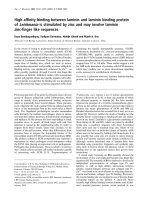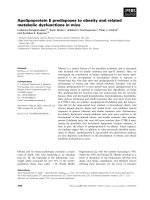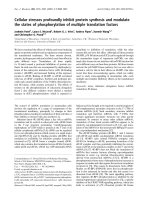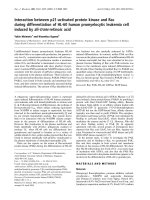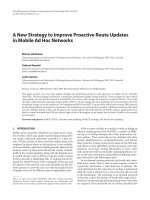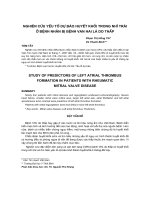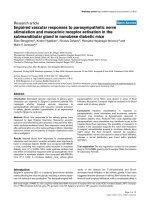Báo cáo y học: "Innovative combination strategy to enhance effect and diminish adverse effects of glucocorticoids: another promise" pot
Bạn đang xem bản rút gọn của tài liệu. Xem và tải ngay bản đầy đủ của tài liệu tại đây (42.68 KB, 2 trang )
Available online />Page 1 of 2
(page number not for citation purposes)
Abstract
In a paper by Zimmermann and colleagues in this issue of Arthritis
Research & Therapy, results of extended laboratory research with
the drug combination of prednisolone and dipyridamole are
reported. There seems to be a boost and extension of the gluco-
corticoid effect by the combination, without a clear increase of
adverse effects, potentially allowing the application of lower
dosages. However, laboratory models are not patients and the
glucocorticoid mechanisms leading to effects and adverse effects
are manifold. The next required step will be to demonstrate the
improved therapeutic window in patients in adequate comparative
clinical trials, assessing predefined beneficial effects and adverse
effects in a standardized way.
In this issue of Arthritis Research & Therapy, Zimmermann
and colleagues, employees of CombinatoRx [1], a company
that specializes in finding and developing synergistic
combinations of (existing) drugs, report on extended in vivo
(rats and mice) and in vitro research with the combination of
the drugs prednisolone and dipyridamole [2]. The results
suggest that this combination has a synergistic immuno-
suppressive effect.
Dipyridamole is a phosphodiesterase inhibitor that increases
intracellular levels of cyclic adenosine and guanine mono-
phosphate by inhibiting their conversion. In platelets, this
leads to reversible inhibition of platelet aggregation, for which
the drug is used, often in combination with low-dose aspirin.
In addition, dipyridamole has several other effects. The
synergistic effect of prednisolone with dipyridamole is des-
cribed as being based on the inhibition of additional
inflammatory mediators, such as chemokine (C-C motif)
ligand 5 (CCL5), also known as RANTES, a proinflammatory
chemokine and matrix metallopeptidase 9 (MMP9), also
known as gelatinase B, an enzyme involved in the breakdown
of extracellular matrix; these additional effects seem limited to
inflammatory cell mechanisms. In collagen- and adjuvant-
induced arthritis, the combination had an equipotent anti-
inflammatory action compared with a considerably higher
dose of prednisolone alone. Furthermore, in models
assessing glucocorticoid-induced adverse effects, the
combination induced fewer adverse effects than prednisolone
alone at the required higher dose for equipotent anti-
inflammatory activity. So there seems to be a boost and
extension of the glucocorticoid effect, without a clear
increase of adverse effects, potentially allowing the
application of lower dosages than would be necessary for
glucocorticoid therapy alone and thus avoiding systemic
adverse effects.
Glucocorticoids are the most effective and generally used
immunosuppressive drugs worldwide in immune-mediated
diseases. The demonstration of disease-modifying capacity of
low-dose glucocorticoid therapy in rheumatoid arthritis has
boosted the interest of rheumatologists in this medication [3].
In early rheumatoid arthritis, the application of combination
therapy of disease-modifying agents, including glucocorti-
coids, has already become a generally accepted strategy.
The advantages of low doses of glucocorticoids outweigh the
disadvantages [4]. The European League Against Rheu-
matism evidence-based recommendations on the use of
glucocorticoids are tools for avoiding adverse effects of
glucocorticoids [5] and aim at using as low a dose as
possible (reconsidering at each clinical visit the need for
glucocorticoids and the dose level) and at preventive
measures such as calcium and bisphosphonates. Another
strategy enabling lower dosing of glucocorticoids and thus
avoiding adverse effects is combination therapy with other
immunosuppressive or so-called steroid-sparing drugs, like
azathioprine and methotrexate.
For many years, research has also aimed at developing new
preparations with beneficial glucocorticoid effects but fewer
adverse effects. The first step, about five decades ago, was
the development of synthetic glucocorticoids such as
Editorial
Innovative combination strategy to enhance effect and diminish
adverse effects of glucocorticoids: another promise?
Johannes WG Jacobs and Johannes WJ Bijlsma
Department of Rheumatology & Clinical Immunology, F02.127, University Medical Center Utrecht, P.O. Box 85500, 3508 GA, Utrecht,
The Netherlands
Corresponding author: Johannes WG Jacobs,
Published: 27 February 2009 Arthritis Research & Therapy 2009, 11:105 (doi:10.1186/ar2615)
This article is online at />© 2009 BioMed Central Ltd
See related research by Zimmermann et al., />Arthritis Research & Therapy Vol 11 No 1 Jacobs and Bijlsma
Page 2 of 2
(page number not for citation purposes)
prednisone and dexamethasone with more potent effects and
fewer mineralocorticoid effects compared with the natural
cortisol. The synthetic glucocorticoid deflazacort (an
oxazoline derivative of prednisolone) was claimed to have the
same anti-inflammatory and immunosuppressive activity as
prednisone with fewer adverse effects but did not fully live up
to expectations [6]. More recently, a modified release tablet
of prednisone was developed, releasing prednisone about 4
hours after ingestion. When this tablet was taken in the
evening (thus synchronising its prednisone release to the
circadian rhythm of cortisol), the duration of early morning
stiffness in rheumatoid arthritis was less compared with that
associated with the same dose of prednisone taken early in
the morning [7]. Further research will have to shed light on
issues such as long-term efficacy regarding all rheumatoid
arthritis symptoms and signs, the effect on radiological joint
destruction, and long-term adverse events of this preparation
[8]. Glucocorticoid analogues that would have dissociated
effects on transrepression and transactivation, like selective
glucocorticoid receptor agonists, and that could have a more
favorable balance of clinical effects and adverse effects than
conventional glucocorticoids are being developed [9].
However, glucocorticoids also have non-genomic actions
(especially at higher doses) and the genomic actions
transrepression and transactivation are not fully synonymous
with inflammatory and immunosuppressive activity and with
adverse effects, respectively. For instance, hypopituitary-
pituitary-adrenal axis suppression and increased risk of
infection are linked to transrepression, not to transactivation.
Another promising development is the targeting of gluco-
corticoids to inflammatory sites using polyethylene glycol
liposomes as a vector, increasing local levels and reducing
systemic concentrations of glucocorticoids and thus limiting
the adverse effects [10]. Glucocorticoid-nitric oxide com-
pounds releasing nitric oxide might exhibit enhanced anti-
inflammatory properties at lower systemic concentrations of
glucocorticoid [11], but these drugs are also still in an early
test phase.
The new development of the CombinatoRx drug is important,
and the results reported by Zimmermann and colleagues [2]
are promising indeed. However, laboratory models, rats, and
mice are not patients and the glucocorticoid mechanisms
leading to effects and adverse effects are manifold.
Ultimately, the proof of the pudding is in the eating. Com-
parative clinical trials of long duration with adequate numbers
of patients and regular assessments of predefined beneficial
effects and adverse effects in a standardized way are
warranted. This is the next challenge.
Competing interests
The authors declare that they have no competing interests.
References
1. CombinatoRx homepage [].
2. Zimmermann GR, Avery W, Finelli AL, Farwell M, Fraser CC,
Borisy AA: Selective amplification of glucocorticoid anti-
inflammatory activity through synergistic multi-target action
of a combination drug. Arthritis Res Ther 2009, 11:R12.
3. Kirwan JR, Bijlsma JW, Boers M, Shea BJ: Effects of glucocorti-
coids on radiological progression in rheumatoid arthritis.
Cochrane Database Syst Rev 2007, (1):CD006356.
4. Da Silva JA, Jacobs JW, Kirwan JR, Boers M, Saag KG, Inês LB,
de Koning EJ, Buttgereit F, Cutolo M, Capell H, Rau R, Bijlsma
JW: Safety of low dose glucocorticoid treatment in rheuma-
toid arthritis: published evidence and prospective trial data.
Ann Rheum Dis 2006, 65:285-293.
5. Hoes JN, Jacobs JW, Boers M, Boumpas D, Buttgereit F, Caeyers
N, Choy EH, Cutolo M, Da Silva JA, Esselens G, Guillevin L, Haf-
strom I, Kirwan JR, Rovensky J, Russell A, Saag KG, Svensson B,
Westhovens R, Zeidler H, Bijlsma JW: EULAR evidence-based
recommendations on the management of systemic glucocor-
ticoid therapy in rheumatic diseases. Ann Rheum Dis 2007,
66:1560-1567.
6. Krogsgaard MR, Thamsborg G, Lund B: Changes in bone mass
during low dose corticosteroid treatment in patients with
polymyalgia rheumatica: a double blind, prospective compari-
son between prednisolone and deflazacort. Ann Rheum Dis
1996, 55:143-146.
7. Buttgereit F, Doering G, Schaeffler A, Witte S, Sierakowski S,
Gromnica-Ihle E, Jeka S, Krueger K, Szechinski J, Alten R: Effi-
cacy of modified-release versus standard prednisone to
reduce duration of morning stiffness of the joints in rheuma-
toid arthritis (CAPRA-1): a double-blind, randomised con-
trolled trial. Lancet 2008, 371:205-214.
8. Bijlsma JW, Jacobs JW: Glucocorticoid chronotherapy in
rheumatoid arthritis. Lancet 2008, 371:183-184.
9. Rhen T, Cidlowski JA: Antiinflammatory action of glucocorti-
coids—new mechanisms for old drugs. N Engl J Med 2005,
353:1711-1723.
10. Koning GA, Schiffelers RM, Wauben MH, Kok RJ, Mastrobattista
E, Molema G, ten Hagen TL, Storm G: Targeting of angiogenic
endothelial cells at sites of inflammation by dexamethasone
phosphate-containing RGD peptide liposomes inhibits experi-
mental arthritis. Arthritis Rheum 2006, 54:1198-1208.
11. Bijlsma JW, Saag KG, Buttgereit F, da Silva JA: Developments in
glucocorticoid therapy. Rheum Dis Clin North Am 2005, 31:1-
17.
